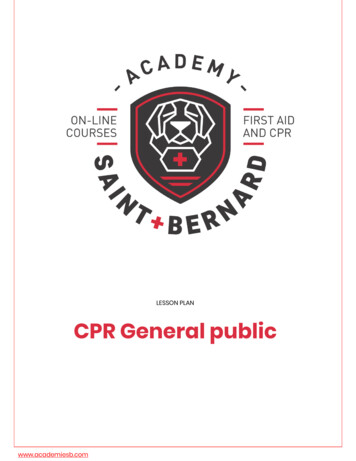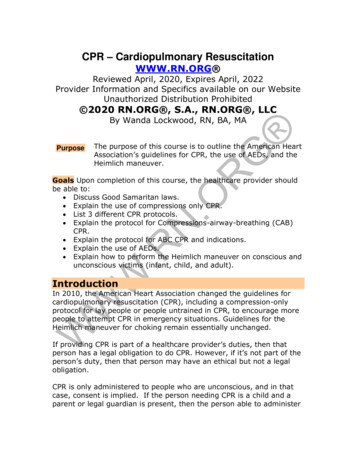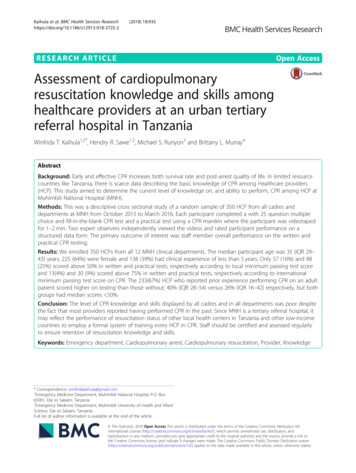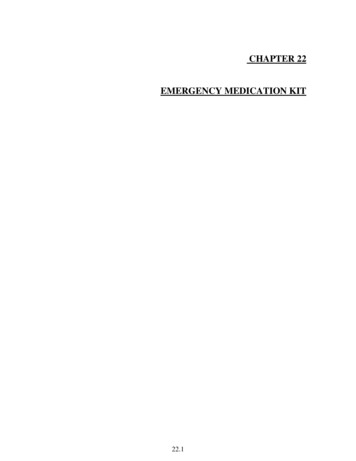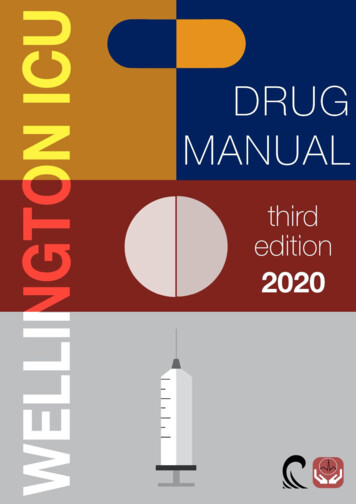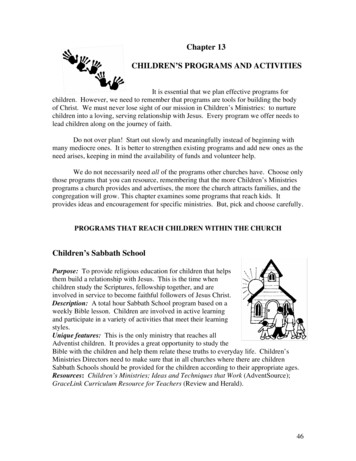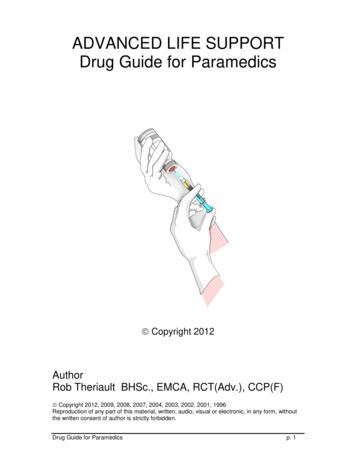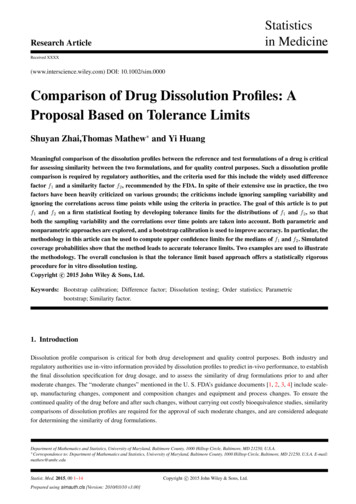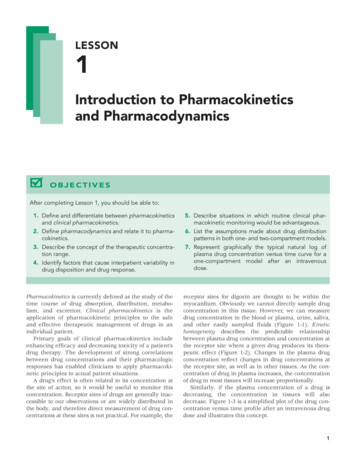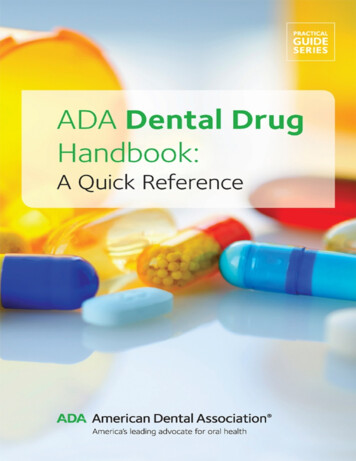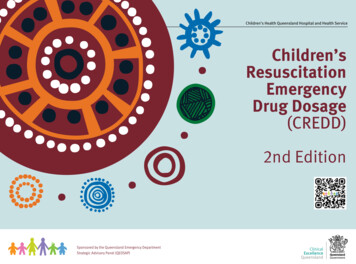
Transcription
Children’s Health Queensland Hospital and Health ServiceChildren’sResuscitationEmergencyDrug Dosage(CREDD)2nd EditionSponsored by the Queensland Emergency DepartmentStrategic Advisory Panel (QEDSAP)
Acknowledgement of countryChildren’s Resuscitation Emergency Drug Dosage (CREDD) 2nd EditionWe pay our respects to the Aboriginal andTorres Strait Islander ancestors and custodiansof this land, their spirits and their legacy.The foundations laid by these ancestors—First Nations peoples—gives strength, inspirationand courage to current and future generations.We are committed to working towards a strongerand healthier Queensland community forAboriginal and Torres Strait Islander andnon-Aboriginal and Torres Strait Islander people.Published by Children’s Health Queensland Hospital and Health Service, June 2021This work is licensed under the Creative Commons Attribution-ShareAlike 3.0 Australia licence.To view a copy of this licence, visit https://creativecommons.org/licenses/by-sa/3.0/au Children’s Health Queensland Hospital and Health Service, 2019You are free to copy, communicate and adapt the work, as long as you attribute Children’s Health Queensland (CHQ) Hospital andHealth Service and distribute under the same licence.Cover artwork produced for Queensland Health by Gilimbaa. The motifs used represent the important network of people fromQueensland communities and how they work together to empower Aboriginal and Torres Strait Islander Queenslanders to have long,healthy, productive lives.For content enquiries or feedback email the CREDD team at CREDD@health.qld.gov.auFor distribution enquiries email the Simulation Training Optimising Resuscitation for Kids (STORK) at STORK@health.qld.gov.auDisclaimerThe content presented in this publication is distributed by the Queensland Government including Children’s Health Queensland as an information source only. The State ofQueensland including Children’s Health Queensland make no statements, representations or warranties about the accuracy, completeness or reliability of any informationcontained in this publication. The State of Queensland including Children’s Health Queensland disclaims all responsibility and all liability including without limitation forliability in negligence for all expenses, losses, damages and costs you might incur as a result of the information being inaccurate or incomplete in any way, and for any reasonreliance was placed on such information.This book has been designed as a cognitive aid to guide drug administration in paediatric emergency situations throughout Queensland. We recommend hospitals followtheir usual practice for endorsement locally including presenting it to their local Medicines Advisory Committee (or equivalent) prior to use. It is designed to be used by staffwith expertise and skills in the management of critically unwell children. We recommend staff become familiar with and receive training in the use of this book prior to usingit. Whilst the information contained herein has gone through a vigorous checking and referencing process it is not a substitute for thinking and checking.
PurposeThis book is a weight-based equipment andmedication guide intended for use by cliniciansmanaging critically unwell children duringthe initial stages of resuscitation. It containsinformation on the recommended dosing,preparation and delivery of drugs administeredin a wide range of paediatric emergencies.The aim of providing this information by weight is to reducethe cognitive burden at the time of resuscitation therebylimiting the potential for error and improving the speed ofmedication delivery.The CREDD book has been developed by a multidisciplinaryteam of clinicians and pharmacists with emergency, paediatric,paediatric intensive care and retrieval expertise.The preparation methods contained in this book usestandardised concentrations to align with the internationalsafety standards of drug preparation.ConsiderationsSecond edition changesThe CREDD book is not a substitute for clinically appropriate,carefully checked medication orders. It is designed to be usedin conjunction with state and/or local resources which containinformation on drug interactions, compatibilities, precautionsand possible side effects.In response to valuable feedback we have made the followingchanges to the 2nd edition.Empiric antibiotic recommendations are beyond the scope ofthis book.The dosing information contained in this book reflects the latestevidence at the time of print and is subject to change. Refer toreferences and the rationale for consensus decisions at the backof this book for further information.The infusion recommendations align with the QueenslandChildren’s Hospital, Paediatric Intensive Care medicationsafety drug profiles. We recommend using drug error reductionsoftware (DERS) on all pumps. For sites without DERS softwarewe have included mL/hr relating to dosing recommendations forthat particular medication when prepared as instructed.For online paediatric emergency resources including a digitalversion of CREDD and further paediatric resuscitation education bySimulation Training Optimising Resuscitation for Kids (STORK) visitthe Queensland Paediatric Emergency Care page on the Children’sHealth Queensland website. Search “CHQ emergency care”or scan the code on the front cover with your phone’s camera.Inclusions: Weights 2.5 kg, 3.5 kg, 4.5 kg. New medication sections- Lignocaine 1% for pain associated with IO medication andfluid administration- Antiarrhythmic medications- Acute Behavioural disturbance medications Fluid recipe appendix.Changes to existing sections: Midazolam IV 0.15 mg/kg – dose change Levetiracetam 60 mg/kg – dose range change Sodium Valproate 40 mg/kg – new medication Infusions- Narrowing of recommended rate range. Top dose capped at ratewhen a dose considered the upper end of usual adult dosing isreached. If clinically indicted, the dose can still be increasecdwithin the programmed DERS pumps soft and hard limits.- Fentanyl added to weights 2 - 9 kg- Morphine STRONG added to weights 26 kg - 70 kg- Midazolam STRONG added to weights 26 kg - 70 kg- Esmolol 2 - 70 kg – new medication- Amiodarone 2 - 70 kg – new medication- A change in the Alprostadil (Open Ductus Arteriosus) doserange 50 to 100 nanogram/kg/min 2 - 6 kgsWhen caring for critically unwell children call for HELP earlyIf no paediatric critical care facility onsite, contact Retrieval Services Queensland (RSQ) on 1300 799 127.If required, Paediatric Critical Care specialists can check dosing and guide clinicians through drug preparation.
How to use CREDDDetermine the weight of the child and find therespective pages for that weight in the book. If the exactweight is not known, it can be estimated (see Table 1).Medications are grouped according to the condition in whichthey are used. Weights range from 2 to 70 kg in predefinedincrements. When the actual body weight is between a weightrange, we recommend rounding up to the nearest kilogram.Clinical judgement is needed for dose selection at theextremes of body weight for a given age.Depending on the medication there is variability in the weight atwhich an adult medication dose is reached. Once adult dosingis reached all weights above this will reflect the adult dose.Equipment selectionEquipment sizing is determined by age.As this book is a weight based guide, the listed size is basedon the expected weight for each age. See Table 1.When using a cuffed Endotracheal tube (ETT) we recommendthe use of an ETT with a micro-cuff. These tubes are designedto seal at a lower cuff pressure with a more anatomicallyfavourable design for paediatric patients.AgeWeightHeightETT micro-cuff sizeBirth (term)3.5 kg50 cm3.01 month4 kg55 cm3.02 months5 kg58 cm3.03 months6 kg61 cm3.04 months7 kg63 cm3.06 months8 kg67 cm3.59 months9 kg72 cm3.51 year10 kg75 cm3.52 years12 kg87 cm4.03 years14 kg96 cm4.04 years16 kg103 cm4.55 years18 kg110 cm4.56 years20 kg115 cm5.07 years22 kg122 cm5.08 years25 kg127 cm5.59 years28 kg134 cm5.510 years30 kg139 cm6.011 years35 kg144 cm6.012 years40 kg150 cm6.0 or 7.013 years45 kg156 cm6.0 or 7.014 years50 kg162 cm7.0Table 1. Average weight and height for age with ETT micro-cuff sizes
Medication recommendationsMedication doses are expressed as the recommended dose/kgand the dose reflects the calculated dose for each weight.Some medications do not require dilution; the preparationinstructions for these state “Undiluted”.Where a dosing range is displayed, the lower dose is providedin the dose column. Certain medications should be titrated tothe desired effect. Careful judgement is needed when managingcritically unwell children. A shocked child is particularlysensitive to the respiratory and cardio depressant effects ofinduction agents and analgesics. Titration of these drugs toeffect with careful attention to correcting hypovolaemia andusing vasoactive agents such as push dose pressor Adrenalineis recommended.When the recommended dose exceeds the contents of one vial,multiple vials may need to be drawn into the syringe to give thedose and final volume to administer.We have aimed to simplify medication administration, andcomply with international medication safety standards,by guiding the user to prepare medications as standardconcentrations, referred to as final concentration. This is familiarpractice in most emergency departments. Where practical,and to minimise error the recommended practice is to drawup the entire contents of specific vials/ampoules and diluteaccording to the preparation/dilution instructions.Unless otherwise indicated, the recommended diluent is SodiumChloride 0.9%. The user is guided in preparing a final concentrationof the drug and the final volume to administer the calculated dose.Rounding rulesFinal volume to administer is calculated according tothe following rules: t he volume has been rounded to two decimal placesfor medication doses which are below1 mL (accurately draw up into a 1 mL syringe)e.g. Adenosine dose 0.4 mg final volume of 0.13 mL single decimal place used for medication doses withvolumes between 1 - 20 mLe.g. Levetiracetam 440 mg final volume of 8.8 mL osing rounded to the nearest mL for medicationddoses with a volume above 20 mLThe wording “consult” replaces the dose when a medicationwould not be recommended due to the age of the child.The administration column provides guidance on medicationdelivery. Medications to be administered as a “push” shouldbe given as rapidly as the vein and volume allows unless atime frame is specified. IV refers to both intravenous andintraosseous routes of administration.When the dose of IV/IO medication to be administered has avolume of less than 1 mL and is required to be given over anytime period between 30 seconds to 5 minutes. The exact dosecan be drawn up in a 1 mL syringe then diluted to a total volumeof 1 mL with a compatible fluid. This enables an exact dose to begiven as specified.Medications given over longer than five minutes shouldpreferably be given as a short infusion. However, where this isnot possible, the medication can be pushed by a staff memberover the specified time frame.“The underlying principle of CREDD is to provide a safe andpractical guide for medication administration in pressuredsituations. For this reason, doses are rounded to a volume thatis easy to draw up and administer. Ideally, we would like to applya blanket rule for rounding doses however this is not alwaysappropriate. In most cases, medications with volumes less than1 mL are rounded to two decimal places and volumes over 1 mL toone decimal place. In some medications, the dose is reflected asthe actual calculated dose and the final volume is rounded to apractical and safe volume to administer.”
AdministrationPush and titratable medicationsInfusions (page 5 of each weight)The recommended procedure for medications to be administered as a push is as follows:All infusion preparations are prepared to produce astandardised concentration in line with the Children’sHealth Queensland and CHQ Retrieval Service andinternational drug safety standards. Unless specified, allinfusions are made up to a concentration which can besafely administered via a peripheral vein. Where a centralvein is advised, this may be achieved by using a centralvein or intraosseous access.1. Prepare the final concentration (Mothership) syringe (A). Ensure it is clearly labelled as per institutional labelling standards.2. Attach a fluid dispensing connector (B) or 3-way tap (C) to an appropriate sized dose syringe (D) that is clearly labelled.3. Draw the exact dose final volume to administer (D) into the dosing syringe.CDABDAFig 1. Final concentration syringe connected to the dose syringe usinga fluid dispensing connector.Fig 2. Final concentration syringe connected to thedose syringe using a 3-way tap.Short infusions and loading dosesHaving prepared the final concentration, ensure only the exact volume to be infused is attached to the syringe pump by either: d rawing up the final volume to administer into a different syringe of appropriate size. i f final volume to administer less than 5 mL it is reasonable to dilute the dose up to a practical volume for the pump to infuse. r, if using the final concentration (Mothership) syringe, discard all excess solution so that the volume contained in the finaloconcentration syringe is limited to the final volume to administer.Administer the exact dose via an infusion pump over the specified time.Infusions are grouped according to the purpose of use.The user is guided in preparation instructions to producea standardised final concentration of drug made up in a50 mL syringe. The recommended dose/kg range is statedin appropriate units (e.g. units/kg/min or units/kg/hr).The final rate range reflecting this dose range is given inmillilitres (mL) per hour. This is to assist sites without smartpumps and drug error reduction software.Some infusions have small volumes and low rates whichcan result in delays in the medication reaching the patient.We recommend the infusion line is connected as close aspossible to the patient IV and commenced at a rate whichensures the medication reaches the patient quickly.The patient should be observed continuously, and theinfusion titrated to effect.Higher concentration solutions options are offered in largerchildren, to minimise the need for infusion changes.
ReferencesProvided below are the references to support the recommendations outlined in this book. Refer to the glossary below for further details on the references.Table 2. References to support medication recommendationsDrugIndicationDoseDilution and final concentrationAdrenalineAnaphylaxis10 microg/kg. Auto-injectorunder 20 kg use 150 microg 1:1000 1000 microg/mLover 20 kg use 300 microgMax dose/adult doseAdministrationReferences0.5 mgIMAscia, AMHc, APLS,ANZCORAdrenalineUpper airway obstruction5 mg5 mLs of 1:10005 mgNebuliserAscia, eTGAdrenalineCardiac arrest10 microg/kg1:10,000 100 microg/mL1 mgIVANZCOR, APLSD/C ShockCardiac arrest shockablerhythmPAD selection size dependanton make of machineAmiODAROneShock resistant VT/VF5 mg/kgGlucose 5% final concentration 10 mg/mL 300mg Adult dose from 60 kgFluid BolusHypovolaemia10 mL/kgSodium Chloride 0.9%Fluid BolusHypovolaemia20 mL/kgSodium Chloride 0.9%Glucose 10%Hypoglycaemia2 mL/kgGlucose 10%Adenosine 1Dependant on model Biphasic150 - 200J Monophasic 360JANZCOR, APLSIVANZCOR APLSANZCOR, APLSIVANZCOR, APLS150 mL repeat to effectIVAPLSSVT0.1 mg/kgUndiluted6 mgIVANZCOR, APLSndAdenosine 2SVT0.2 mg/kgUndiluted12 mgIVANZCOR, APLS, AMHAdenosine 3rdSVT0.3 mg/kgUndiluted12 mg from 40 kgIVANZCOR, APLS, AMHstSynchronisedcardioversionAtropine1 - 2 J/kgBradycardia20 microg/kgAdult 50 J 100 J 200 JDilute to 100 microg/mL600 microgAPLS, ANZCORIVAPLS, ANZCOR, AMHRoss et al 2018,Scott Weingart 2017Push Dose PressorIntermittent administration of small doses of vasopressors for hypotension particularly associated with Intubation.Useful as a temporizing bridge to inotrope infusion commencing. Below 40 kg Adrenaline is preferred over Metaraminol.AdrenalineHypotension1 microg/kg10 microg/mL50 microg at 50 kgPush in 1 mL aliquotsif multiple dosesneeded start infusionRoss et al 2018,Scott Weingart 2017MetaraminolHypotension10 microg/kg500 microg/mLMax 0.5 mg per doseUse over 12 yearsMax 1 mL bolusesrepeated up to 5 mgBNFcFentanylSedation2 - 5 microg/kg10 microg/mL100 microgTitrate to effectAMHKetamineSedation1 - 2 mg/kg10 mg/mL200 mgTitrate to effectAMHcPropOFOlSedation2 - 3 mg/kg10 mg/mLTitrate to effectAMHc, BNFcMidazolamSedation/seizure0.15 mg/kg1 mg/mLIVAMHcRocuroniumMuscle relaxation1.2 mg/kg10 mg/mLSuxamethoniumMuscle relaxation2 mg/kg10 mg/mL10 mg150 mgIVQCH, ShannIVQCH
DrugIndicationDoseDilution and final concentrationMax dose/adult doseAdministrationReferencesVecuroniumMuscle relaxation0.1 mg/kg1 mg/mL10 mgIVAMH, ShannSugammadexRocuronium reversal16 mg/kg100 mg/mLIVAMH, ShannFlumazenilBenzodiazepine reversal5 microg/kg100 microg/mLMax single dose 200 microgcan go up to total dose 2 mgIVAMHc, BNFcNaloxoneOpioid reversal10 microg/kg400 microg/mL400 microgIV/IMAMH, QCHDexamethasoneSevere croup0.3 mg/kg4 mg/mL12 mgIV/IMCHQMagnesium SulfateAsthmaPolymorphic VT0.2 mmol/kg0.2 mmol/mL10 mmolIVAMHc, QCH, PIGHydrocortisoneAdrenal crisis, Asthma4 mg/kg50 mg/mL200 mgIVAMHc, CHQMethylprednisoloneAsthma1 mg/kg40 mg/mL60 mgIVCHQSalbutamolAsthma load0.1 mg/kg0.1 mg/mL5 mgIVCHQAminophyllineAsthma load5 mg/kg5 mg/mL500 mgIVCHQMidazolamSeizure0.2 mg/kg5 mg/mL10 mgIMAMHcMidazolamSeizure0.3 mg/kg5 mg/mL10 mgNasal/buccalAMHcPhenytoinStatus epilepticus20 mg/kg10 mg/mL1500 mgIVAMHc, APLSPhenobarbitalStatus epilepticus20 mg/kg20 mg/mL1000 mgIVAMHc, APLS, BNFcLevetiracetamStatus epilepticus60 mg/kg50 mg/mL4.5 gIVLyttle et al 2019Sodium ValporateStatus epilepticus40 mg/kg40 mg/mL3gIVCHQ, AMHCMannitol 20%Raised ICP0.5 g/kg0.2 g/mLIVCHQ, BNFcSodium Chloride 3%Raised ICP3 mL/kg0.5 mmol/mL150 mLIVCHQPotassium ChlorideHypokalaemia0.3 mmol/kg0.1 mmol/mL premixed bag20 mmol/hrIVCHQCalcium GluconateHypocalcaemia,Hyperkalaemia0.11 mmol/Kg0.2 mmol/mL4.5 mmol 20 mL 10%IVBNFcSalbutamol NebsHyperkalaemia2.5 mg under 6 years5 mg over 6 yearsNebRCHFrusemide1 mg/kg1 mg/mLIVAMHc, BNFcSodium bicarbonate 8.4%Hyperkalaemia1 mmol/kg1 mmol/mLIVBNFc, RCHResonium AHyperkalaemia0.25 g/kgDilution chosen for ease of administrationPO/PRBNFcBloodBlood lossAnaemia10 mL/kgAs clinically indicated. Blood loss 10 - 20 mL/kg and reassess. Elective transfusion equationchild under 20 kg. mL weight (kg) x desired Hb rise g/L (desired Hb g/L–Actual Hb g/L) x 0.510 mL/kg usually 2 g/L riseAPLS, ANZCORTranexamic acidLarge blood loss15 mg/kg10 mg/mL1000 mgIVAMHcFentanylAnalgesia1.5 microg/kg50 microg/mL100 microgINAMHFentanylAnalgesia0.1-1 microg/kg10 microg/mL100 microgIVAMHMorphineAnalgesia0.05-0.1 mg/kg1 mg/kg10 mgIVAMH
DrugIndicationDoseDilution and finalconcentrationMax dose/adult doseAdministrationReferencesLignocaine 1%Analgesia for IO infusions0.5 mg/kg10 mg/mL40 mg initial20 mg subsequentMAX 60 mgIO follow dose with 1 mL Sodium Choride 0.9%flush over 2 min. Dwell for 1 min. Rapid flush 5 mL.Half original dose can be repeated as aboveQAS, PCCMAmiODAROne (load)Antiarrhythmic5 mgGlucose 5%2 mg/mL300 mgUse 0.22 micronFilter load over 4 hours 20 - 25 microg/kg/minANZCOR, AMHc, PIGEsmolol (load)Beta blocker SVT0.25 - 0.5 mg/kgUndiluted500 microgPush over 1 - 2 minAMHc, BNFc, PIGEsmolol (infusion)Beta blocker50 - 300 microg/kg/min Undiluted500 microg/kg/minTitrate in 25 - 50 microg/min incrementsAMHc, PIGVerapamilSVT0.1 MG/KG1 mg/mL10 mgInfuse over 5 - 10 minAMHc, BNFc, PIG, AIDDiazepamBehavioural disturbance0.2 mg/kg1 mg/mL10 mgPOQHG, RCHLorazepamBehavioural disturbance 40 kg 0.5 - 1 mg 40 kg 1 - 2 mg2 mgPODose bandingCHQ, RCHOlanzapineBehavioural disturbance 40 kg 2.5 - 5 mg 40 kg 5 - 10 mg10 mgPODose bandingQHG, CHQRisperidoneBehavioural disturbance0.02 - 0.04 mg/kg2 mgPODose bandingQHG, RCHDroperidolBehavioural disturbance0.1 - 0.2 mg/kg10 mgIMQHG, CHQOlanzapine IMBehavioural disturbance0.2 mg/kg 40 kg 2.5 - 5 mg 40 kg 5 - 10 mg10 mgIMDose bandingCHQ, RCHBenztropineDystonic reaction0.02 mg/kg1 mgIM/IVCHQ, AMHcUndiluted 2.5 mg/mLUndiluted 1 mg/mLTable 3. References to support equipment Tube sizes are calculated according to age. As this is a weight based book we have used 50th centile weights for age fromAMH to determine weights at which tube size and depth of insertion changeAPLSETT cuffedCalculated as Age/4 3.5 for children 1 year or older. ETT with average weight for age representedAPLS, Micro cuff ETT www.halyardhealth.co.ukETT uncuffedCalculated as Age/4 4.0 for children 1 year or older. ETT with average weight for age representedAPLSDepth at lipsCalculated as Age/2 12 for children 1 year or older. Newborn 8 cm, 6 months 10 cm, 1 year 12 cmAPLSDepth at noseCalculated as Age/2 15 for children 1 year or older. Newborn 10 cm, 6 months 13 cm, 1 year 14 cmAPLSLMA sizeUnder 5 kg 1, 6 - 10 kg 1.5, 11 - 20 kg 2, 21 - 30 kg 2.5, 31 - 50 kg 3, 51 - 70 kg 4ANZCORIDC and Nasogastric tube 2 x uncuffed ETTStandard practiceIntercostal catheterStandard practice4 x uncuffed ETT
GlossaryAMHAustralian Medicines Handbook July 2019, amhonline.amh.net.auAMHcAustralian Medicines Handbook Children’s Dosing Companion July 2019, childrens.amh.net.auANZCORAustralian Resuscitation Council, Australian New Zealand Resuscitation Council (ANZCOR) Guidelines; January 2016 resus.org.au/ guidelines/anzcor-guidelinesASCIAAustralasian Society of Clinical Immunology and Allergy, July 2019, www.allergy.org.auAPLSAustralian Paediatric Life Support Australia; August 2017 www.apls.org.auBNFcBritish National Formulary for Children July 2019, ’s Health Queensland Hospital and Health Service Queensland Paediatric Guidelines, August 2019, ionals/qpec-statewideguidelineseTGTherapeutic guidelines, June 2019, tgldcdp.tg.org.au/etgAccessLyttle, M. et al 2019Levetiracetam versus phenytoin for second-line treatment of paediatric convulsive status epilepticus (EcLiPSE): a multicentre, open-label, randomised trial. The Lancet,2019;393:2125-2134, -6736(19)30724-X/fulltextPCCMPrimary Clinical Care Manual - 10th edition Section 8: Paediatrics, al-care-manual-10th-editionPIGPaediatric Injectable Guidelines 2019 July 2019, pig.rch.org.au/monographsQASQueensland ambulance service field reference guideQCHQueensland Children’s Hospital Paediatric Emergency Drug Preparation GuideQHGQueensland health guideline Acute behavioural disturbance in Emergency Departments, www.health.qld.gov.au/ data/assets/pdf file/0031/629491/qh-gdl-438.pdfShann 2017Shann: F 2017 Drug Doses, Reservoir, VictoriaRCHThe Royal Children’s Hospital Melbourne Royal Children’s Hospital Clinical Guidelines www.rch.org.au/homeRoss et al 2018Physiologic response to pre-arrest bolus dilute epinephrine in the pediatric intensive care unit. Resuscitation, 2018, Volume 126, 137-142Scott Weingart 2017 emcrit.org/emcrit/push-dose-pressor-update
Rationale for consensus decisionsAnaphylaxisThroughout the book, we have recommended in a health carefacility where 1 mg/mL (1 in 1000) Adrenaline is available toadminister the exact 10 microg/kg IM dose for anaphylaxis.If 1 mg/mL is not available an autoinjector should be used.For children 7.5-20 kg use the 150 microg (0.15 mg) autoinjectorand children weighing above 20 kg use the 300 microg (0.3 mg)autoinjector.The risk of anaphylaxis is quite low in young children weighingless than 7.5 kg. If Adrenaline is needed for anaphylaxis in achild weighing less that 7.5 kg and if 1 mg/mL Adrenaline is notavailable the risk of administering a ‘fixed’ overdose via a 0.15 mgautoinjector device is considered to be lower than the risk of notadministering any Adrenaline.Mini-JetsDue to unreliable availability we have opted to prepare mostcommonly used resuscitation drugs e.g. Adrenaline and Atropineinstead of using mini-jets.MetaraminolWe have recommended the use of a pre-prepared diluted solutionof Metaraminol 5 mg/10 mL 500 microg/mL available throughcentral pharmacy. This is to minimise the steps that would beinvolved in preparing the medication from the 10 mg/mL vial.1Intravenous SalbutamolThe current evidence to support the Salbutamol IV bolus andinfusion dosing is limited and practice varies considerablythroughout Australia1. The dosages contained in this book alignwith the current Queensland Paediatric Asthma Guideline.The bolus dose is significantly higher than the current practice inEurope2 which is informed by the British National Formulary forChildren (BNFc) and that recommended in the Australian MedicinesHandbook (AMH) and the Australian Medicines Handbook Children’sDosing Companion (AMHc). The CREDD authors opted to align withthe Queensland Paediatric Asthma Guideline on the basis thatsalbutamol toxicity seems to be well tolerated by children.3 If IVsalbutamol is clinically indicated and there are significant concernsregarding Salbutamol toxicity it may be preferable to omit the loadand commence the infusion starting at the upper rate range.PhenytoinProduct information advises Phenytoin should be administered at amaximum concentration of 10 mg/mL. The user is guided in dilutingwhole vials to a final concentration of 10 mg/mL. For doses above 500mg (50 mL) we have guided the user to prepare 100 mL of the 10 mg/mL solution by diluting 20 mL (1000 mg) in a 100 mL 0.9% sodiumchloride mini-bag. The dose can then be taken from this 100 mL.We have chosen a maximum loading dose of Phenytoin of 1 g.This reflects the initial loading dose that would be administered toan adult. If further Phenytoin above 1 g is needed, the additionaldose can be prepared as per instructions for that additional dose.MorphineMorphine is available in a variety of concentrations. To standardisepreparation instructions, we have recommended using the readilyavailable 10 mg/mL preparation to produce the final concentrationof 1 mg/mL. If an alternate concentration of morphine is used itwill be necessary to change the diluent volume to produce a finalconcentration of 1 mg/mL.InfusionsIn the 2nd edition of CREDD there have been changes made tothe rate and volume ranges of a number of infusions.The 1st edition reflects soft limits of DERS software for eachmedication. At times this allows for the maximum adult doseto be exceeded. Whilst this may be appropriate in somecircumstances, we have chosen to narrow these ranges to avoidexceeding usual adult dose. The unit/kg/time at the top of therecommended rate range reflects this dose cap. The CREDD teamdo not recommend adjusting the current DERS pump hard andsoft max limits.Medications affected and usual upper dose limits for adultinfusions are below: Adrenaline (Epinephrine) 20 microg/min Noradrenaline (Norepinephrine) 20 microg/min Fentanyl 150 microg/hr Ketamine 100 mg/hr Propofol 150 mg/hr Vecuronium 10 mg/hr Babl FE, Sheriff N, Borland M, Acworth J, Neutze J et al. Paediatric acute asthma management in Australia and New Zealand: practice patterns in the context of clinical practice guidelines. Arch Dis Child 2008; 93:307–312.2 2019 BTS/SIGN: British guideline on the management of asthma: A national clinical guideline. Revised June 2019 nt/guidelines/asthma/3 Starkey ES, Mulla H, Sammons HM, Pandya HC. Intravenous salbutamol for childhood asthma: evidence-based medicine? Arch Dis Child 2014; 99:873–877.
Authors and acknowledgementsCREDD team leads and steering committee r Christa Bell, Emergency Physician and Paediatric EmergencyDPhysician – Medical lead, Gold Coast University Hospital (GCUH) Karyn Dahms, Pharmacist Advanced – Womens, Newborns andChildrens Services – Pharmacy lead, GCUH Kayla Doyle, Senior Paediatric Pharmacist Operational Portfolio– Pharmacy lead, Sunshine Coast HHS Lauren Morgan, Paediatric Critical Care CNC– Nursing lead, Sunshine Coast University Hospital (SCUH)The following individuals were responsible for the creation of theCREDD database calculator: aryn Dahms, Pharmacist Advanced – Womens, Newborns andKChildrens Services – Pharmacy lead, GCUH Courtney Vesey, Senior Paediatric Pharmacist Lead,Sunshine Coast HHS Kayla Doyle, Senior Paediatric Pharmacist Operational Portfolio– Pharmacy lead, Sunshine Coast HHS Dr Christa Bell, Emergency Physician and Paediatric EmergencyPhysician – Medical lead, GCUH L auren Morgan, Paediatric Critical Care CNC– Nursing lead, SCUHThe CREDD team would like to thank Clinical ExcellenceQueensland and the Queensland Emergency DepartmentStrategic Advisory Panel for providing the funding to enable theidea to become a reality and CEQ engage for their assistance inpreparing the electronic file.The CREDD team would like to acknowledge the followingclinicians for their contribution:The CREDD team would also like to acknowledge the followingindividuals for their role in the production of the book:Children’s Health Queensland Hospital and Health ServiceAnn-Maree Brady, Clinical Nurse Consultant, Children’sHealth Queensland Retrieval Services (CHQRS); Michele Cree,Pharmacist Critical Care Lead, Queensland Children’s Hospital(QCH); Louise Dodson, Nurse Educator, Simulation TrainingOptimising Resuscitation for Kids (STORK); Lisa Gabb, NurseEducator, CHQRS; Dr Paul Holmes, Director, CHQRS; LorettaScaini, Nurse Educator Paediatric Intensive Care Unit, QCH;Dr Fiona Thomson, Clinical Director Emergency, QCH and Cochair, Queensland Emergency Care of Children Working Group.Children’s Health Queensland Communications and EngagementMatthew Douglas, Digital Engagement Manager;Megan Drew, Graphic Designer; Lauren Hurlstone, M
The CREDD book has been developed by a multidisciplinary team of clinicians and pharmacists with emergency, paediatric, paediatric intensive care and retrieval expertise. The preparation methods contained in this book use standardised concentrations to align with the internati
